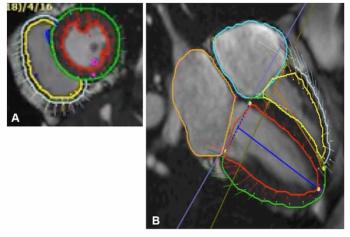
Cardiac MR identifies patients for valve surgery
Oxford University researchers have established that aortic regurgitation fraction, measured with cardiac MR, accurately singles out patients who need aortic valve replacement.
Oxford University researchers haveestablished that aortic regurgitationfraction, measured with cardiac MR,accurately singles out patients whoneed aortic valve replacement.
Patients with aortic regurgitationpose a challenge, especially when theyare asymptomatic, said principal investigatorDr. Saul G. Myerson duringthe opening session of the 2008Society for Cardiovascular MagneticResonance meeting.
Physicians have traditionally reliedon physical symptoms to guide surgicaldecision making, he said. For somepatients, measures of excess left ventriculardilation or dysfunction areappropriate, but they force the clinicianinto a balancing act. Severe LVdilation can lead to the death of somepatients, while for many others it hasno effect for years.
"That would mean we would operateon them unnecessarily in somecases," Myerson said.
Aortic regurgitation measurementhas not so far guided patient managementbecause its acquisition withechocardiography, the conventionalchoice for such quantification, is difficult.Myerson and colleagues foundthat CMR is easier to perform and canbe added to the protocol for measuringLV function. Their study examinedthe clinical utility of the CMRmeasures and the optimal thresholdsto guide therapy.
Fifty aortic regurgitation patientswere examined. Of that number, 33Regurgitant fraction was calculated from shortaxisviews during steady-state free precessioncine sequence. Through-plane, velocity-encodedphase mapping was used to quantify regurgitation.Slices were placed as close to aortic valve aspossible. (Provided by S. Myerson)were asymptomatic. Their conditionswere established with a baseline CMRscan and monitored with annual CMRfor up to five years. The symptoms ofseven of the asymptomatic patientsbecame serious enough to require surgery.Myerson referred to them as thecrossover group.
The nonprogressing symptomaticpatients and crossover patients werecompared with 17 surgical patients,who exhibited conventional physicalindications for a surgical intervention.The surgical group received only abaseline CMR scan before surgery.
Compared with the LV measures,regurgitant fraction was far better ableto predict disease progression. Nopatient with a regurgitant fraction ofless than 20% progressed. About 18%of patients with fractions from 21% to30% progressed, and more than twothirdsof patients with fractions morethan 33% went on to surgery. Themodality's sensitivity and specificitywere 100% and 77%, respectively. Allpatients at or above the 33% thresholdwere classified as good candidates forimmediate valve replacement surgery,Myerson said.
Aortic regurgitation fraction alsoaccurately predicted the progressionto surgery for the 33 asymptomaticsubjects. All 19 patients with values ofless than 33% survived more than fiveyears, compared with a 40% survivalrate for the 14 patients with regurgitantfractions of more than 33%.
Based on the findings, Myersonexpressed confidence in the value ofCMR measurement of aortic regurgitationfraction as an early andaccurate way of designating candidatesas qualifying for surgery orconservative therapy.
"I would suggest that we startthinking about using these measuresto plan which patients would be mostappropriate for surgery," he said.
-By James Brice
Newsletter
Stay at the forefront of radiology with the Diagnostic Imaging newsletter, delivering the latest news, clinical insights, and imaging advancements for today’s radiologists.


























